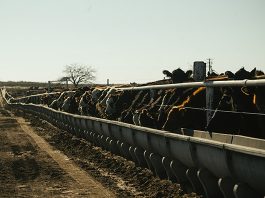A recent report on NPR noted that grass fed beef is becoming more and more popular. In fact, George Seimon, a founder of Organic Valley, says that though the push for grass-fed beef started with activists who wanted to challenge an industry dominated by factory-scale feedlots, the demand for the product has now gone mainstream. That should be good news. But the supplier response wasn’t exactly what activists may have expected. It turns out a lot of the grass-fed beef found in mainstream markets is coming from half a world away. And, in the process of selling this beef to American consumers, one marketer in particular, Sprouts, is telling a story that throws American beef under the bus.
So who is buying all this imported beef? Though Organic Valley is largely known as a supporter of local farmers, according to the NPR report, all of their grass-fed beef comes from Australia. D’Artagnan, an online purveyor of gourmet meats, gets it’s grass-fed beef from Australia, and what it calls “pasture raised beef” from Oregon. (To D’Artagnan and their consumers, pasture raised means that the animals grew up on the range and were then grain finished.) Whole Foods imports only about 3 percent of their grass-fed supply, with the rest coming from regional and local markets.
And why are they buying imported beef? Price is probably the most important factor. Patricia Whisnant and her husband own and operate Rain Crow Ranch, and they supply grass fed beef to Whole Foods. Patricia told NPR that they were once approached by a meat broker interested in supplying grass fed beef to supermarkets. The deal fell through when the broker chose to purchase ground beef from Australia at 75 cents to a dollar less per pound. Australian, Uruguayan, and Brazilian ranchers all have grass year round, making it easier and less expensive to produce grass-fed beef.
But where does this leave consumers who were hoping to impact the way beef is raised in the United States – to move it from feedlots to pastures and ranges? They successfully created a demand for a different/better product. But instead of creating change, suppliers met the demand by importing the product. Are the suppliers correct when they say they have to import grass-fed beef because not enough is being produced here in the U.S.? Or is it because the suppliers or their customers aren’t willing to pay for the product to be produced locally?
We’d like to hear from you. If you’re raising grass-fed beef, do you have a good market for it? What is your experience in trying to reach the mainstream market? Is it a matter of supply or price that most affects where you sell your product?
As I looked into this topic, I found some interesting things about how importers market their product. Next week we’ll share what Sprouts market says about how Uruguayan beef beats American beef for taste and environmentally friendliness.




Our motivation is to naturally raise and humanely butcher livestock, not to have a lot of land/critters to supply the masses/mainstream markets. Yes, we want to make money, but we know not everyone appreciates this gentler approach to raising food animals.
The folks who only want cheap and/or imported (unknown quality) products (meats, dairy, veggies, processed junk) are not in our “target” market. To each their own…
I produce grass fed/grass finished beef in South Louisiana. We have been doing it here since 2005. The market has definitely grown in the last few years, but there are still some obstacles to growth out there. I think it is a combination of supply and price that is affecting us reaching the mainstream market. We have been approached by several restaurants and health food stores, but all they want is ground meat, and they want it for less than we can afford to sell it. They also want a steady supply of a few hundred lbs, sometimes every week, and that just isnt possible for our farm right now. We are in the process of expanding our herd, but that cant happen overnight, due to the quality standards we have in place for our beef. We have expanded our market base using a local farmers market, but we run into the same supply problem with running out of ground meat when we still have lots of premium cuts left to sell. It has definitely been a learn as you go experience, but I wouldnt rather be doing anything else.
Good insight in this article. Plus: huge swaths of rainforest are cut every year in Brazil to make way for grass-grazing, since that’s what the government considers ‘agriculture’, therefore eligible for subsidy. So important for more responsible graziers to find a way to distinguish responsible grass-fed from ecosystem-destroying grass-fed.
I AGREE, BUT THAT’S A TOUGH NUT! WE HAVE TO MARKET OUR PRODUCT ON IT’S MERITS NOT ONLY AS GREAT BEEF AGAINST MASS PRODUCED GRAIN FED, BUT NOW ALSO PRESERVATION OF RAIN FORREST!
THE SIMPLEST WAY OUT IS ALREADY IN PLACE- STAY SMALL BUY LOCAL AND KNOW YOUR PRODUCER.BUT THERE WILL BE MANY, ESPECIALLY CIY MICE, WHO WILL NOT CARE ENOUGH TO MAKE THAT EFFORT.
i’M HOPEFUL THAT AS MORE FOLKS GET MORE FOCUSED ON CLIMATE CHANGE AND MORE EVIDENCE EMERGES THAT PROPERLY MANAGED GRAZING CAN SEQUESTER CARBON FROM ATMOSPHERE INTO SOIL, AND REALIZE THAT SAVARY IS RIGHT “THERE’S NO OTHER SOLUTION” for getting it down, AND REALIZE THE BENEFITS OF SHORT DISTANCE TRANSPORT- MAYBE WE (or our kids)WILL WIN OUT!
FOR THOSE WHO MAY BE OUT OF LOOP -TRY TedTalks 2013,Allan Savary Fighting Climate Change, and/ or wwwSoil Carbon Coalition or google Judith D Schwartz -Her paperback, COWS SAVE THE PLANET is EXCELLENT
Comments are closed.